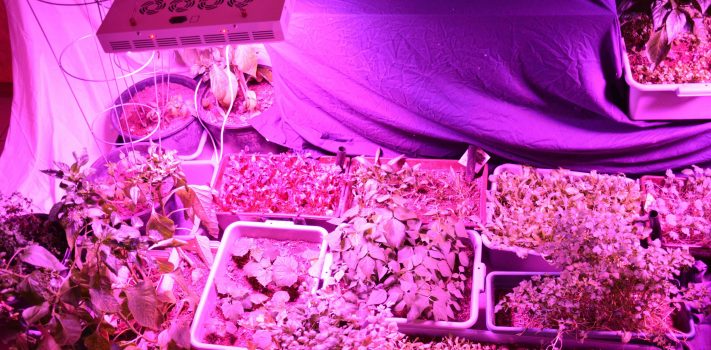Our Winter Indoor Greenhouse Room
by Avalanche Lily, Survival Blog:

I was recently asked for any advice that I could give concerning growing foods indoors. Growing anything indoors or outdoors is always an experiment, because there are so many variables to contend with. In essence: Indoors: humidity, light, and nutrition. Outside: sunspots (or lack thereof), temperature, cloud cover, rain, drought, storms, bugs, soil nutrition, et cetera.
Let me preface that I have no claim at all in thinking that I’m an expert. I’m not. I am no expert at all, nor am I an expert in any subject. I am a “by the seat of your pants” kinda girl. I just get a general idea of something that I am interested in doing. I do some basic research and then get the equipment needed, and do it. I don’t try to be the best, the expert, or to do anything perfect. That stresses me out! There will always be people who do it better, neater, more professionally, have a better method, be more organized, have more ingenuity, are faster, or with more knowledge. I just want to do projects for fun, in a simple manner, experimentally, to see what happens, and then improve it for the next iteration, if it is worth the time and energy.
Therefore, with this in mind, I will tell you about my indoor garden, what I have done, for fun and learning, with the goal of growing some of our own food. I’ll relate my trials and tribulations, and what my results have been. I’ve organized this as a scientific experiment and report. I’ve done so in a loose framework of a Scientific Research Paper which consists of: Introduction, Methods and Materials, Results, Discussion, and Conclusion.
INTRODUCTION
Many people in the SurvivalBlog community and others have recently observed the claimed “climate change” occurring around the world. We have seen adverse weather events (such as late freezes and early frosts, high wind rain storms, hail storms, drought and lack of rain, too much rain and flooding) which has destroyed crops and livestock during the past two years. The sun has cycles of eleven years, but for the two most recent cycles, there have been dramatically fewer sunspots. The mainstream media is barely reporting on this — keeping the general public at large in the dark. What is really happening is that we are entering a Grand Solar Minimum, and there will be global cooling, not warming, perhaps for many decades. The mass media will not tell you about the approaching food crises which will lead to food scarcity and famines. It won’t be until there is profound cooling that they try to claim that it is the “Climate Change” that they had warned of.
Those of us who aware and proactive are already growing our own gardens and are preserving our own foods through canning, dehydration, freezing, and even freeze-drying. Crops can be protected in short growing seasons with greenhouses, hoop houses,and even indoor gardening. Indoor growing only works if one has electricity. This article describes my experiment with growing vegetables indoors, in a guest bedroom.
MATERIALS AND METHODS
Here are the materials that I am using:
- Soil sourced from my garden
- Gray plastic bussing trays, (bought from the Smart Foodservice restaurant supply store in Spokane, Washington)
- Long, shallow, under the bed type totes (Walmart)
- Large planter pots, (left over from buying garden fruit plants or trees)
- Two 600-watt LED grow lights (that we bought from Ready Made Resources)
- Organic heirloom seeds bought from Johnny’s, Seed Savers, High Mowing, Baker’s, and some local stores,
- and well water.
This is being done in the spare/guest bedroom. No, I don’t usually use store-bought fertilizers or plant food.
About the garden soil. My garden soil consists of a mixture of the basic garden soil, kitchen scrap compost, and cow/chicken manure compost. I boost the soil with minerals, such as magnesium salts and gypsum. I collected my soil from the garden this year in mid-summer, after harvesting a crop. I rototilled that harvested section and then shoveled off a very thin top layer to be used in my planters for starting seedlings this next spring, and for my indoor garden. Someone mentioned in the Prepping Progress comments that they had aphid/bug problems when they used their own garden soils. I wish to say that, thankfully, we have had very minimal bug problems over the years from using my garden’s soil. (Caveat: See my Update).
The garden soil has a few baby worms, a few small beetles, centipedes, spiders, earwigs, ants, some small flying insects, and other very tiny critters, which all tend to stay in the pots/trays or in their vicinity. I keep my Zap It electric flyswatter nearby for any critters who venture out from the safety of their trays such spiders, beetles, earwigs, and ants). They are quickly spotted because of our light-colored tile floors. Aphids are hardly an issue here, because, this is my theory, we live in between National Forest tracts, there are very few homes and thus very few gardens in this region. And therefore very few of your normal garden pests, thus far…..). I vacuum very frequently, so wayward critters are quickly sucked up and drowned in our Rainbow vacuum tank. I don’t mind a few critters, as long as they stay in the bedroom and very close to or in the trays. It’s kinda fun to see insects and very small animal life in the trays in the dead of winter.
About the Lights: The two LED grow lights were hung from the ceiling to about the three foot level above the floor. Most of the time, I turn them on around 8 AM, and turn them off around 10 PM. Therefore, the plants receive between 11-to-15 hours of light per day. The lights have fans to whisk the heat away. This heat from the lights adds warmth to the room. Watering the plants and evaporation from the soil and the heat of the lamps raises the humidity. Stepping into the bedroom, feels often like one has stepped into a tropical rain forest. A friend of ours who was investigating our set-up, quipped, “I feel like I just transported from the snowy American Redoubt to Costa Rica, in an instant”. When it gets too hot and humid in there, the window sweats and drips water. When this happens, I wipe the window and the sill with a towel, then open the window for a few minutes to cool the room and to lessen the humidity. I do not want the wood bed frame, mattress, table, dresser, and desk to become too wet and develop mold. The windowsill and window frame have occasionally developed mold. Therefore they must be wiped frequently.
The Room: We have light tile floors throughout much of our house. We don’t like rugs that much because they retain too much dirt, dust, and allergens. Because, the bedroom floor is tiled we’re not too concerned if a little bit of water gets on the floor or infrequent leaks from the trays or pots.
The floor space of the indoor garden is approximately 46 square feet and currently consists of seven bussing trays, five large planter pots, six windowsill type planters, and three wide windowsill planters.
The bed, dresser, and desk surfaces are off limits to holding planters. I don’t wish to ruin them with leaking water or damp spilled soil. I only use one little side table to hold a bussing tray and I am scrupulous about wiping up any spilled water.
RESULTS
Since each year indoor gardening like outdoor gardening is an experiment, the produce that grows is the result/reward So then, I will now tell you what my results have been the last time I grew something indoors, two winters ago. Last winter, I took a break from indoor gardening. Two winters ago I grew and harvested lettuces, kales, spinach, yellow zucchini, green beans and got tomatoes to flower, and start to produce baby tomatoes, by the time the spring growing season arrived. They were then transferred outside. A couple of years previous to two winters ago, I only used the grow lights to start my summer seedlings in the house in March.
This year, I started the indoor garden about one month ago. I started tomatoes from seed which are now eight inches tall, I brought in my peppers from the greenhouse, and since they had gotten a wee bit cold out in the greenhouse and I had had them in the bedroom for about a week with no extra light, they began losing their leaves. Jim and I set up the lights and now, about five weeks later, they are growing back their leaves, have put out new flowers and some are even growing new peppers, already.
The French Green beans have put out their tertiary leaves and I see buds beginning to form for another set of leaves and flowers. As of Monday night, they are flowering. I’m so excited.
The cucumbers, also have put out their tertiary leaves. I do not expect anything out of them until January or February. I will be putting some kind of trellis in their tray to help them not to sprawl, to give them the room they will need through climbing vertically.
The lettuces, kales, spinach, and herbs: parsley, cilantro, celery, beets, and basil are doing very well in their trays. I’ve been harvesting already, the lettuces, parsley, kale, beets and spinach greens. I am succession planting these greens. I intend to plant another tray of them in a couple of weeks.
Loading...



